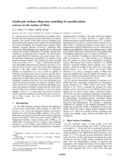| dc.contributor.author | Olsen, K. S. | |
| dc.contributor.author | Cloutis, E. | |
| dc.contributor.author | Strong, K. | |
| dc.date.accessioned | 2018-03-06T19:42:19Z | |
| dc.date.available | 2018-03-06T19:42:19Z | |
| dc.date.issued | 2012-10-11 | |
| dc.identifier.citation | Olsen, K. S., E. Cloutis, and K. Strong. "Small-scale methane dispersion modelling for possible plume sources on the surface of Mars." Geophysical Research Letters 39 (19) (2012): L19201. DOI: 10.1029/2012GL052922. | en_US |
| dc.identifier.issn | 0094-8276 | |
| dc.identifier.uri | http://hdl.handle.net/10680/1387 | |
| dc.description.abstract | Intense interest in the characteristics of a methane source on Mars has been spurred by recent observations of a plume structure. The current NASA Mars Science Laboratory and future landers and orbiters will be tasked with understanding the sources of methane. The Canadian Space Agency’s Mars Methane Analogue Mission, involving a simulated Mars micro-rover field campaign, was recently able to detect and measure the isotopic composition of methane seeping from boreholes in a serpentine mine in Québec. We aim to determine spatial limits for detecting such a point source above the terrestrial background concentration of methane using gradient transport models. We estimate the source strength to be on the order of 5.3 x -10 kg s -1 and find that this produces detectable enhancements at distances less than 11.6m from the source if there is no wind. These same models are applied to the Mars surface environment to determine whether an instrument on a rover would be capable of detecting a methane point source when not directly downwind of it. The estimated source strengths on Mars are much greater than at Jeffrey Mine and we find that these would be detectable at distances less than 30m from the plume axis, which lies along the direction of advective transport. Much of the work done on modelling the Martian atmosphere uses large-scale general circulation models and this work examines the behaviour of methane plumes at very local scales. | |
| dc.description.sponsorship | The M3 analogue mission to Jeffrey Mine was funded by the Canadian Space Agency (CSA) and operated through MPB Communications. M3 is a collaboration between MPB, the University of Winnipeg, McGill University, Carleton University, the University of Toronto, and the Université du Québec à Montréal. | |
| dc.description.uri | https://agupubs.onlinelibrary.wiley.com/doi/abs/10.1029/2012GL052922 | |
| dc.language.iso | en | en_US |
| dc.publisher | Geophysical Research Letters | en_US |
| dc.rights | info:eu-repo/semantics/openAccess | |
| dc.title | Small-scale methane dispersion modelling for possible plume sources on the surface of Mars | en_US |
| dc.type | Article | en_US |
| dc.identifier.doi | 10.1029/2012GL052922 | |

